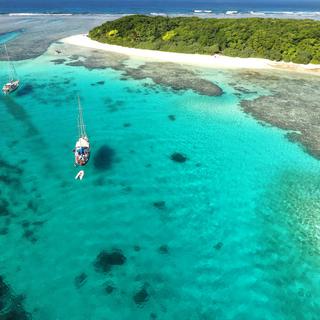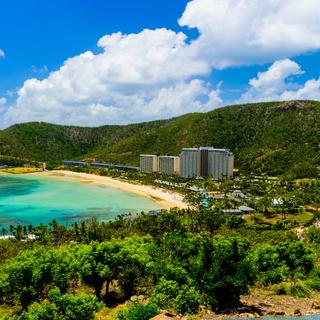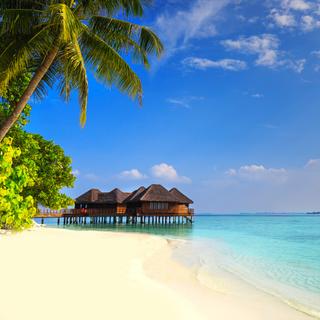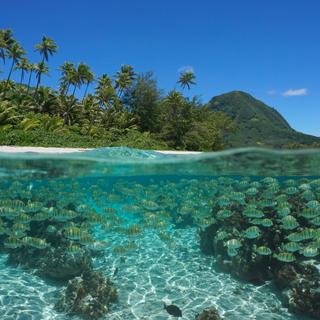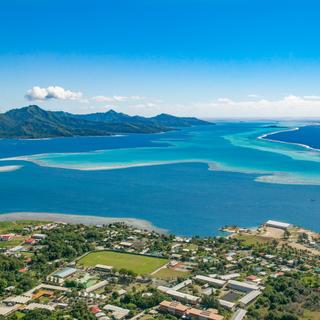
Moorea weather and climate

Moorea weather and climate
Day
26 °C
Night
20 °C
Sea
27 °C
Precipitation
87 mm
in month
Rainy days
5 days
in month
Daylight
11 hours
average
Weather charts for Moorea

Find more destinations like this
Destinations with similar weather to Moorea
Other destinations in French Polynesia
Weather overview for Moorea
Weather overview
The island of Moorea in French Polynesia enjoys a tropical climate with temperatures that vary throughout the year. Daytime temperatures range from a mild 26 °C (78 °F) in August to a warm 29 °C (85 °F) in March. During the night, expect the highest temperatures to be in February at around 23 °C (73 °F), and the coolest nights are usually in August, when temperatures drop to 20 °C (68 °F). The sea also reflects these thermal variations, with the warmest sea temperatures in March at 29 °C (84 °F) and cooler waters in August at 26 °C (79 °F). Intermittent rainfall patterns distinguish the months; February typically sees the most precipitation with 20 days of rain, whereas August is generally the driest month with only 5 days of rainfall. Here is a tailored overview of Moorea's monthly weather, focusing on specific aspects of the local climate.
January weather
The commencement of Moorea's wet season is characterized by the gradual decline in rainfall, with a total precipitation of 204 mm (8.05 in). Concurrently, a rise in day temperatures commences, reaching 29 °C (84 °F), and an ascent in night temperatures is noted, reaching 23 °C (73 °F). Despite these developments, the peak in sunshine hours has not yet been observed, nor has the peak in humidity levels.
February weather
The wet season is clearly underway in Moorea. Rainy days peak, amounting to 20 days, while precipitation levels continue their downtrend. The night temperature reaches its zenith at 23 °C (73 °F).
March weather
During this period, Moorea experiences the pinnacle of day temperature as well as sea temperature, registering 29 °C (84 °F) respectively. The wet season is impending; the number of rainy days begins to recede to 18 days, and the rainfall amount also sees a continued reduction, recorded at 167 mm (6.57 in).
April weather
Moorea witnesses the beginning of a downturn in day temperatures, with a recorded value of 29 °C (83 °F). The wet season persists, with a continuing decline in rainfall at 131 mm (5.14 in), and a decrease in the count of rainy days to 15 days. The wind intensity reaches a minimal point in April.
May weather
The tourist season gradually picks up in Moorea. A decline in day temperatures to 27 °C (81 °F) is noted, alongside the commencement of a reduction in sea temperatures to 28 °C (82 °F). Rainfall steadily decreases to 125 mm (4.92 in), and similarly, the frequency of rainy days subsides to 10 days. A noticeable decline in night temperatures caps the month.
June weather
The approaching peak of the tourist season in Moorea is accompanied by a continual dip in day temperatures to 26 °C (80 °F), and sea temperatures also retract compared to the previous month, stabilizing at 27 °C (81 °F). A parallel descent in wet days to 6 days and rainfall intensifies, with a value of 98 mm (3.85 in). The night temperature further regresses, measuring at 21 °C (69 °F).
July weather
Notably, July in Moorea sees the descent of day temperatures to 26 °C (79 °F), and a continuing decrease in sea temperatures to 27 °C (80 °F). The ongoing tourist season is extant. The count of rainy days recedes once more to 5 days, and the rainfall volume further diminishes, with its value at 87 mm (3.41 in). Night temperatures hold steady, registering a slight decline to 20 °C (68 °F).
August weather
Moorea records the lowest day temperatures of the year in August, paralleled by the minimum in sea temperatures, which stand at 26 °C (79 °F). This month also marks the nadir of rainy days at 5 days, and the most negligible rainfall volumes are observed as well, listed at 79 mm (3.13 in). Amid the peak tourist season, the coolest night temperatures are experienced, registering at 20 °C (68 °F).
September weather
As the tourist season wanes in Moorea, so does the dry season. September sees a modest uptick in rainy days to 6 days, coupled with the inception of increased rainfall, totaling 103 mm (4.07 in).
October weather
Moorea's tourist season nears its pinnacle, just as the dry season reaches its zenith. Day temperatures begin a gradual increase to 27 °C (80 °F), accompanied by a rise in night temperatures to 21 °C (69 °F). Rising precipitation levels are observed in October, with a value of 123 mm (4.86 in).
November weather
With day temperatures ascending to a pleasant 28 °C (82 °F) in Moorea, and the onset of rising sea temperatures at 27 °C (81 °F), the tourist season maintains its presence. The climb in rainfall becomes more apparent, reaching to 168 mm (6.63 in), and the number of rainy days escalates to 7 days. Night temperatures continue their upward trend, now at 22 °C (71 °F).
December weather
The sustained tourist season in Moorea is marked by an ascension in rainy days to 13 days, correlated with the peak in rainfall, which is quantified at 236 mm (9.28 in). A visible rise in sea temperatures to 28 °C (82 °F), and the elevation of night temperatures is similarly noted, measuring at 22 °C (72 °F). The extension of the day length is notably at its longest in December.
FAQs
As the wet season begins, what is the average daily temperature in Moorea in January?
With the onset of the wet season, January's average daytime temperature in Moorea is a warm 29 °C (84 °F).
How many rainy days are there in Moorea during the peak of the wet season in February?
February, at the height of the wet season in Moorea, records approximately 20 days of rainy days.
What is the trend for daytime temperature and sea temperature in Moorea during March?
In March, Moorea sees the highest levels for both daytime temperature, at 29 °C (84 °F), and sea temperature.
Does Moorea's wet season continue through April, and if so, what is the rainfall trend?
Indeed, April continues within Moorea's wet season, featuring a downtrend in rainfall, now at 131 mm (5.14 in).
How does the changing weather in May influence the tourist season in Moorea?
In May, the milder weather, with day temperatures decreasing to 27 °C (81 °F) and a diminishing number of rainy days, signals the beginning of a more favorable tourist season in Moorea.
What changes occur in the climate of Moorea in June, contributing to the tourist season's peak?
With day temperatures reaching a more temperate 26 °C (80 °F) and a reduced chance of rain, June heralds the near peak of Moorea's tourist season.
How does the weather shift in July influence outdoor activities for visitors in Moorea?
July's temperate climate with comfortable day temperatures around 26 °C (79 °F) and modest rainfall makes it ideal for visitors to engage in outdoor activities in Moorea.
What aspects of Moorea's August weather make it particularly attractive to tourists?
The favorable blend of the year's lowest day and sea temperatures, minimal rainfall, and cooler nights in August makes Moorea exceptionally appealing to tourists.
Does September's climate in Moorea signal a transition from the dry season?
September's slight increase in rainfall and rainy days in Moorea suggests a transitional phase from the dry to the wet season.
What climatic changes start occurring in Moorea in October as the dry season peaks?
October sees a warming trend in both day and night temperatures, hinting at the conclusion of the dry season in Moorea with increasing levels of precipitation.
Is the increased rainfall in November a precursor to the wet season in Moorea?
Yes, the increase in November's rainfall and number of rainy days in Moorea may be a harbinger of the impending wet season.
What distinguishes December's climate in Moorea, and how does it affect the tourist season?
December's climate in Moorea is characterized by mounting rainfall and longer day lengths, yet the tourist season remains vibrant thanks to the gradual rise in temperatures and the extended hours of daylight.


